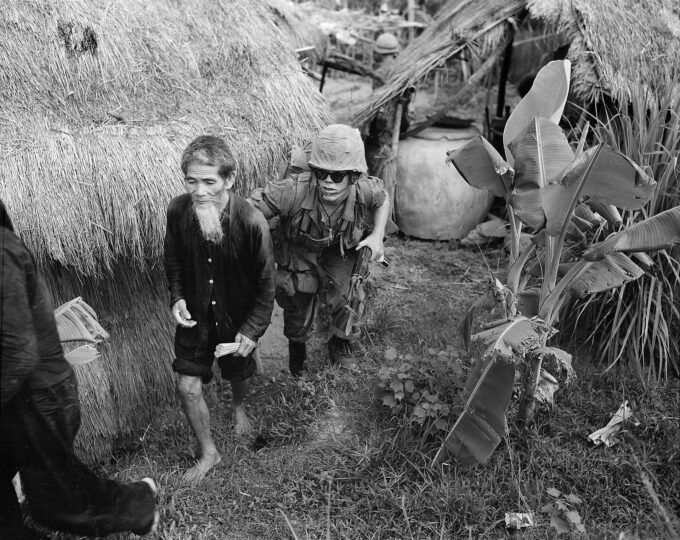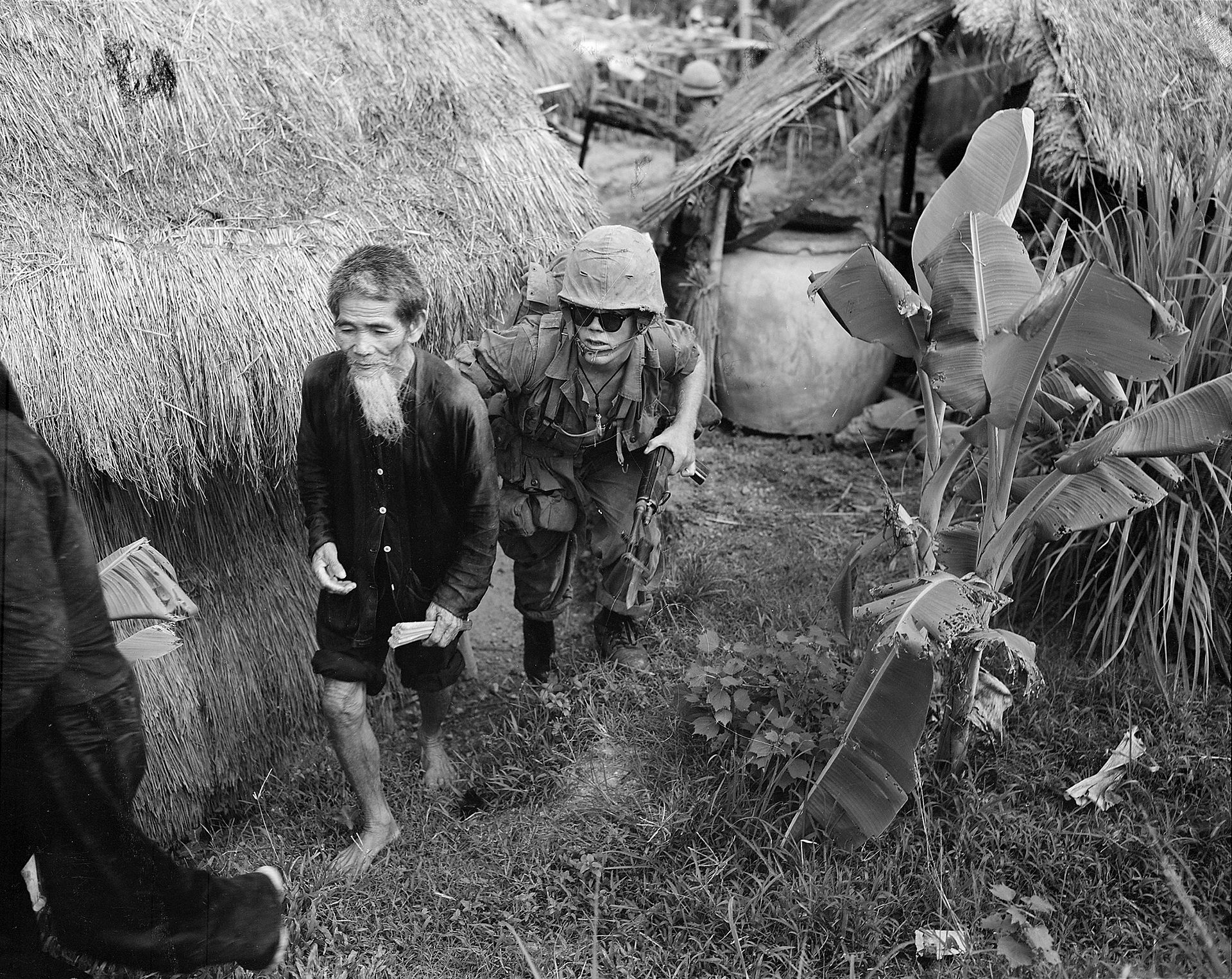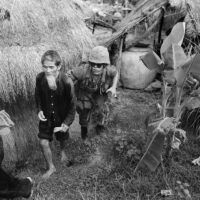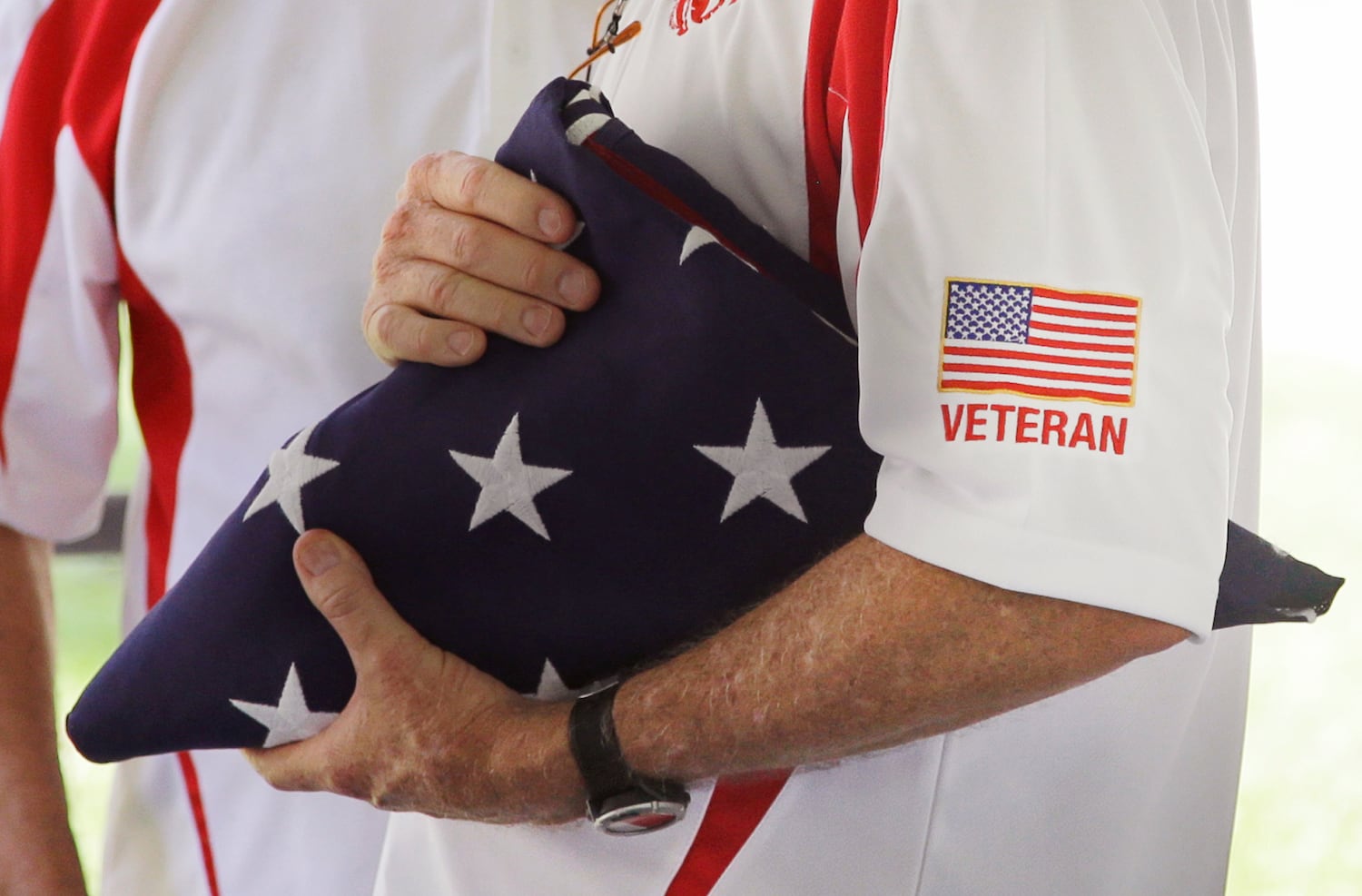






























































A Marine from 1st Battalion, 3rd Marines, moves a Vietnamese peasant during a search and clear operation 15 miles west of Da Nang Air Base, 1965. Photo: PFC G. Durbin, US Marine Corps.
“The Vietnamese national character is rapidly changing. Our value system is falling apart. Gangsters are making incredible fortunes on the black market.”
–Professor Hoang Ngoc Hien, Hanoi intellectual, 1995
“We’re getting wonderful cooperation from the Communist Party. What we need now is more accountability on the part of the Vietnamese.”
–Bradely Babson, Director, World Bank, Hanoi office, 1995.
The War in Vietnam pushed me out of academia, turned me into an anti-imperialist and cast a long shadow on my life. The March on the Pentagon, the 1968 Tet Offensive, May Day in 1971, and helicopters hovering above Saigon— all of them seem like yesterday. For my parents and for members of their generation who survived the Depression of the 1930s and the Red Scare of the 1950s, “the” war was World War II when fascism was defeated and the atomic age began with the US bombing of Hiroshima and Nagasaki. For my generation and at least two generations that followed it, “the” war was Vietnam, which lasted more than a decade and brought about the loss of millions of lives, both Vietnamese and Americans.
I never served in the military and was never drafted. A lucky bastard. Along with tens of millions of people around the world I protested against the war beginning in 1964 and until the war’s end in 1975. I wrote and distributed leaflets, marched, rioted, burned my draft card and went to jail. The war in Vietnam, which the Vietnamese call “the American war” — to distinguish it from the wars against the French and the Japanese—divided American society between pro-war “hawks” and militarists and anti-war “doves” and pacifists.
I remember when Che Guevara called for “Two, Three, Many Vietnams.” I remember he went to the Congo and to Bolivia to foment guerrilla warfare that he hoped would provoke and overextend the US militarily and lead to the end of American hegemony. With help from the CIA, Bolivian troops captured and assassinated him; his dream of a global anti-imperialist revolution driven by the Third World fizzled. What’s difficult to conjure is the zeitgeist, the sense of being permanently on the edge and on fire.
Didn’t the U.S. teeter on the brink of a civil war. I was sure it did and that was prompted by rise of Black Power, bloody riots in big cities like Detroit, the assassinations of Malcolm and Martin, the Kennedys and more, the women’s and the gay liberation movements, young men who went into exile in Canada and France rather than go to Vietnam, and a counterculture that lured a generation or two away from white American values and into the world of sex, drugs, rock ‘n’ roll and rebellion.
For a time it seemed to me and to my circle of self-proclaimed revolutionaries, and to the circles beyond that circle, as though the American Empire, like the Roman and British empires before it, was destined to decline and fall. We were waiting for an end that never came. Maybe imperialism wasn’t the highest stage of capitalism.
Maybe Lenin was wrong, and maybe Mao was also wrong. After the US military defeat in Vietnam, the Empire struck back. George Lucas was right about that. Imperial America rebounded slowly and steadily and the flowers of decadence blossomed from Hollywood to Wall Street, the Hamptons to Miami Beach and beyond. Society is rotten to the core. Where are the barbarians and when will they arrive to upend the empire?
Now, in 2025 the policies and politics of the Trump administration tell me that the American Empire still has fangs and can still frighten ministers and presidents from Mexico City to Manila. Though for how much longer remains to be seen. It’s only a matter of time. Empires can take decades to fall apart.
I remember meeting the American anti-war novelist, Kurt Vonnegut, the author of Player Piano, The Sirens of Titan, Cat’s Cradle, and SlaughterHouse Five, which is set during WWII but wasn’t published until the Vietnam War when it became a bestseller.
As an American soldier Vonnegut was captured by the Germans and imprisoned in a slaughterhouse in Dresden which the Allies bombed and nearly destroyed. “Our side did terrible things during WWII,” the British novelist and Nobel Prize Winner Doris Lessing told me. I had assumed “we” were the “good” guys and didn’t commit the kinds of atrocities the Germans committed in World War II. Vietnam lifted the veil and revealed American barbarism.
In Vietnam in 1995, two decades after the end of the war, when I was a tourist, I came to the sobering conclusion that Lessing was correct about “our side,” and also that no one “wins” a war today; there are only losers. Lessing introduced me to Vonnegut’s fiction and it was Vonnegut who insisted that the pen is not always mightier than the sword. Indeed, while many wonderful anti-war books have been written and widely read, including Stephen Crane’s The Red Badge of Courage, (1895) Erich Maria Remarque’s All Quiet on the Western Front (1928) and Dalton Trumbo’s Johnny Got His Gun (1939), anti-war novels have not ended war.
Still, it seems likely that antiwar novels will continue to be written and read. My favorite is The Sympathizer by Viet Thanh Nguyen, who was born in Vietnam in 1971 and who came to the US in 1975. He’s also the author of The Committed. In The Sympathizer, Nguyen dissects American culture, and lampoons Americans who “pretend they are eternally innocent no matter how many times they lose their innocence.” Fuck American innocence. In The Committed, the novel explores the brutalities behind the veneer of French culture. “Everything sounded better in French,” the narrator explains, “including rape, murder, and pillage!” The author describes the baguette as the “symbol of France and hence the symbol of French colonization!” Nearly everything in his world triggers his reflections about empire, invasion, occupation and liberation. He advises readers to take revolutions seriously but not revolutionaries.
In the late 1960s, I learned about the war in Vietnam from American soldiers, some of them wounded in action, others suffering from Post Traumatic Stress Disorder (PTSD) and some of them baby-faced 19- and 20-year -olds who were students in the literature classes I taught at the State University of New York at Stony Brook. John Brown, an officer from a wealthy family, had pursued an “enemy” soldier down a foxhole only to have a grenade go off in his face, which doctors stitched back together and with visible scars. When he slept at my apartment he’d wake with nightmares.
Sad to say there will be no end to wounded veterans of wars, no end to civilian casualties and surely no end to anti-war movies. My favorites include Grand Illusion, Paths of Glory, The Human Condition, Apocalypse Now!, and Full Metal Jacket. During the War in Vietnam I read dozens of articles by the Australian journalist Wilfred Burchett and half a dozen or so books about the war, mostly non-fiction, including Frances FitzGerald’s Fire in the Lake, and Michael Herr’s Dispatches, plus the poems in Ho Chi Minh’s Prison Diary, which he wrote in Chinese characters while he was a prisoner of the Chinese in 1942 and 1943.
Ho’s Diary was not published in English in the US until near the height of the War in Vietnam, when it became widely read and appreciated. Since its initial publication it has been translated into 37 languages. Ho’s immortal line still haunts me. “When the prison doors are opened, the real dragon will fly out,” he wrote. My favorite non-fiction book, Giai Phong! The Fall and Liberation of Saigon (1976), is by the Italian journalist Tiziano Terzani. It belongs on a bookshelf alongside John Reed’sTen Days that Shook the World that chronicles the Bolshevik Revolution of 1917.
In 1971, when I published The Mythology of Imperialism, a study of British literature and the British Empire, I dedicated it to Ho Chi Minh, the founder of the Vietnamese Communist Party and the President of Vietnam who was born in 1890 and who died in 1969. When I wrote about Conrad’s novella 1899, Heart of Darkness, which is set in the Belgian Congo, the war in Vietnam was never far from my thoughts. Kurtz, Conrad’s anti-hero was the quintessential imperialist. “Exterminate all the brutes,” he writes.
Of all the 20th century communists, Ho is in my book the most likeable, the least horrific. The Declaration of Independence had inspired him. In Hanoi in 1995, on the 20th-anniversary of the end of the war, I visited Ho’s mausoleum which was guarded by soldiers with guns. I met Vietnamese men a decade older than I who had fought in the 1950s against the French who were decisively defeated at the battle of Dien Bien Phu.
I also met Vietnamese who were too young to have fought against the French or the Americans. Nguyễn Huy Thiệp was the only Vietnamese man I met who belonged to the same generation as I did. We bonded at his home, which had been in his family, he said, for 700 years, and at his restaurant on the banks of the Red River in Hanoi where we talked about his short stories, including “The General Comes Home,” an anti-war classic in which a general goes home from a war and no one pays him any attention.
When Thiệp learned that I had friends in Hollywood he wanted me to connect him to them. At his restaurant, which specialized in “jungle food,” I ate snake and “paddy” rat which apparently only eats rice. In my hotel, I disliked the clouds of cigarette smoke that filled the air nor did I appreciate the playing of the International on loudspeakers in the streets which woke me at 7 a.m. every morning. The veterans of the war against the French sat in cafes, sipped green tea and smoked cigarettes all day long. I sat in one of the cafés with them and read Graham Greene’s prophetic novel, The Quiet American about an undercover CIA agent. It was the perfect novel to read there and then.
Professor Hoang Ngoc Hien, one of Hanoi’s leading intellectuals, told me in my hotel room: “The Vietnamese national character is rapidly changing.” He added, “Gangsters are making incredible fortunes on the black market.” On the other side of town Bradley Babson, the director of the World Bank’s Hanoi office told me when I visited him in his office, “We’re getting wonderful cooperation from the Communist Party. What we need now is more accountability on the part of the Vietnamese.”
After a month of talking and touring, looking, listening and learning, Hanoi was tattooed in my heart, Vietnam tattooed in my soul. I will never forget the streets which were swept clean every evening by a battalion of women armed with brooms and shovels, or the young Vietnamese men who took me to see Arnold Schwarzenegger movies and wanted me to explain “special effects.” They had lived in Moscow and had learned Russian. Now they wanted me to teach them English. I was happy to oblige. If they had anti-American sentiments I never heard them or saw them.
I was in Hanoi during Tet, which a Vietnamese translator explained was a combination of The Fourth of July, Christmas and New Years. I never saw so much shopping and so many buoyant people in the streets. I met members of General Giap’s family, ate food specially prepared for Tet and drank Scotch with a former Vietnamese diplomat who had translated into Vietnamese Gone With the Wind and The Adventures of Huckleberry Finn. Oddly enough he identified with the defeated South in Margaret Mitchell’s epic about the American Civil War.
Out of favor with the Communist Party, the former translator complained that the Hanoi government was selling state-owned enterprises to private companies and taking the capitalist road. No imperial power was forcing it to do that, but investors and entrepreneurs were seizing the opportunity to make money. I met a financier with the World War newly arrived in Hanoi with high hopes for profitable ventures. Vietnam was an independent nation, choosing its own future. Isn’t that why we had opposed the American invasion and occupation and the long brutal war against the Vietnamese. So, Vietnam could decide its own future independent of the USA? Yes, I thought so. When Tiziano Terzani wrote his book about the fall and liberation of Saigon, one of his translators told him, “Inside every Vietnamese there’s a mandarin, a thief, a liar who sleeps—but there’s also a dreamer.” That sounds about right. To that list I would add, “and a survivor.”
The post Memories of Vietnam: The War and the Peace appeared first on CounterPunch.org.
This post was originally published on CounterPunch.org.























